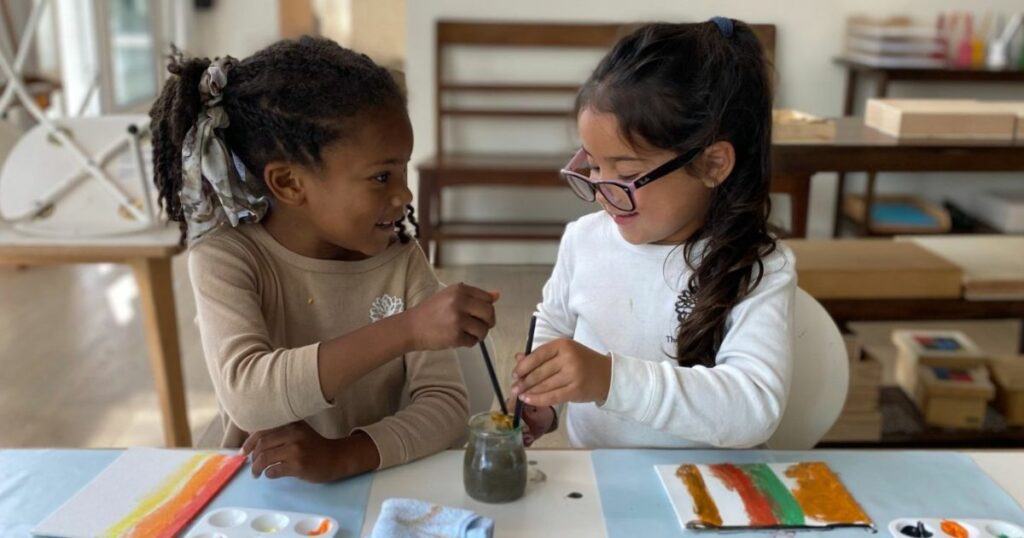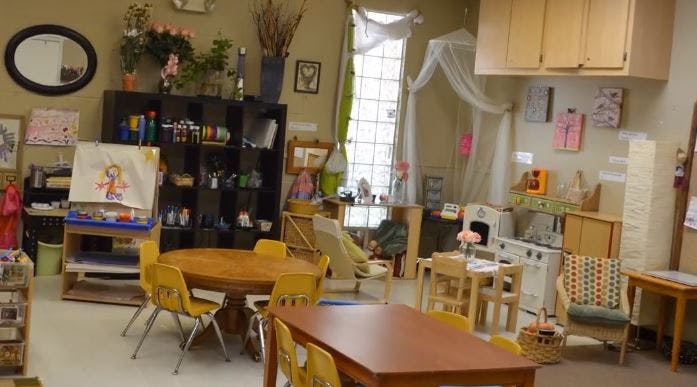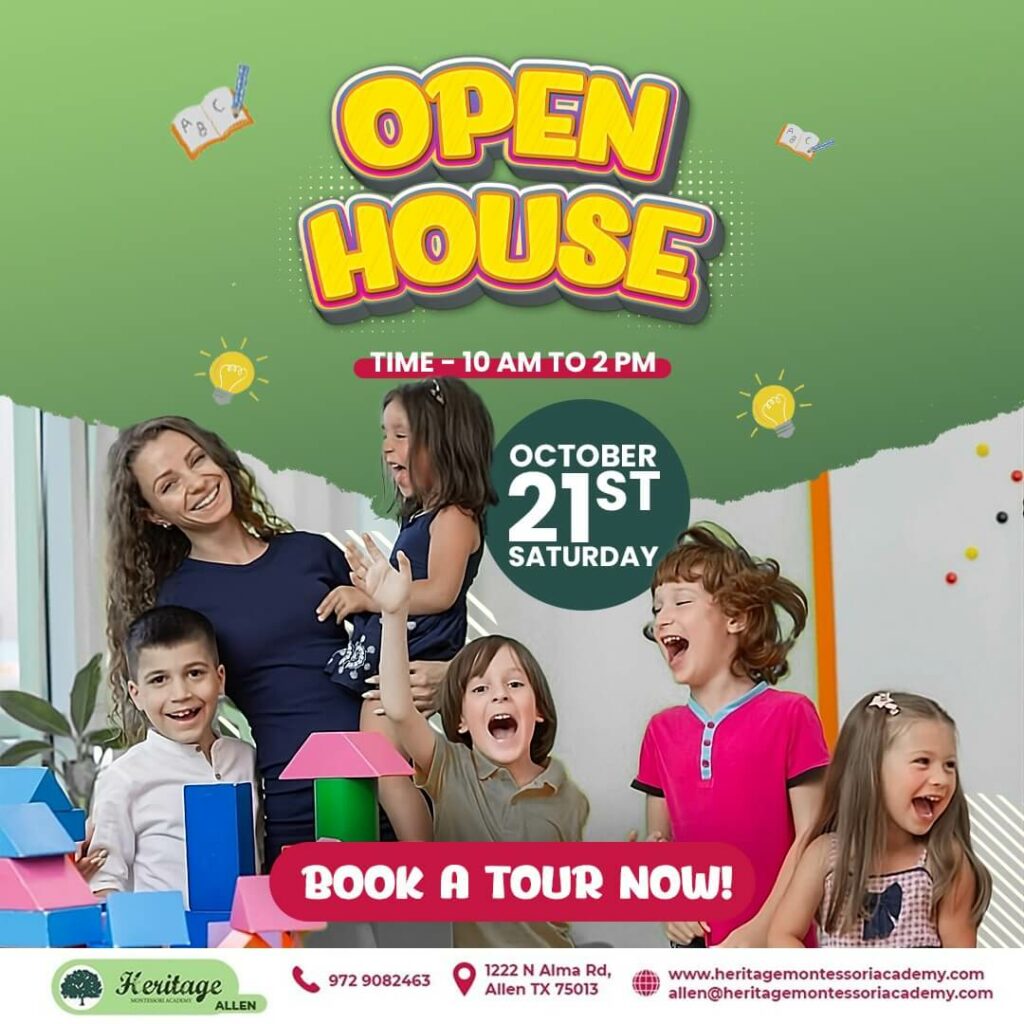Holistic Language Acquisition: Beyond the Classroom Walls
For Dr. Montessori, learning was always about the ‘whole child’. Language acquisition, in this framework, is not isolated to rote memorization or textbook drills. It’s an experiential journey where children, through their innate curiosity, absorb languages from their surroundings. In Montessori settings, environments are crafted to be linguistically rich, with labels, songs, stories, and conversations flowing seamlessly between multiple languages. At its core, this method perceives language not merely as a tool for communication but as an intricate weave that connects cognitive, emotional, and social development. In traditional educational settings, language learning often confines itself to textbooks, repetitive drills, and rote memorization. In contrast, Montessori’s vision advocates for a more organic, immersive experience. Natural environments, filled with sensory experiences, become dynamic language labs. Montessori classrooms, with their mixed-age groupings, naturally promote peer-to-peer interactions. These interactions become particularly potent in bilingual or multilingual settings.
Montessori’s approach, with its emphasis on holistic development, naturally aligns with these findings. The method doesn’t just aim to produce students who can speak multiple languages; it seeks to nurture globally-aware, culturally-sensitive individuals equipped with the cognitive and social tools to thrive in an interconnected world.
Immersion: The Montessori Way
Immersion is a cornerstone of the Montessori linguistic approach. Rather than structured, segmented lessons, children experience languages organically throughout their day. This mirrors how we naturally acquire our first language—through consistent exposure and practical usage. In Montessori classrooms, you might find a child counting in Spanish, singing in French, and conversing in English, all in one day. This fluidity helps children internalize languages deeply, promoting genuine bilingualism or multilingualism. In many conventional schools, language classes are treated as separate entities — sessions where students sit, often disengaged, memorizing vocabulary and grappling with grammar rules. The Montessori approach challenges this norm. Here, language isn’t confined to a timetable slot; it’s woven into every aspect of the curriculum. Be it math, science, or art, multilingual expression becomes a natural part of the process. Language, according to Montessori’s vision, is more than just words and syntax; it’s a gateway to cultures, histories, and worldviews. Immersion in Montessori classrooms goes beyond linguistic proficiency. It delves deep into cultural nuances. Celebrations, stories, culinary explorations, and artistic endeavors bridge the gap between language and the vibrant tapestry of cultural contexts it represents.
Cultural Exploration: A Window to the World
In the Montessori paradigm, languages are more than communication tools. They are gateways to cultures. As children explore a language, they are simultaneously delving into the customs, stories, arts, and values of the people who speak it. This cultural immersion nurtures global citizens who appreciate and respect diversity. Every language has its genesis, an origin rooted in the traditions, history, and experiences of a people. In Montessori environments, when children embark on the journey of learning a new language, they’re not just memorizing words. True to Montessori’s hands-on approach to learning, a plethora of materials are employed to immerse children in cultural exploration. Be it the puzzle maps that let them visualize the geographies of different linguistic communities, or the cultural boxes filled with artifacts representing different countries, these materials transcend textbook learning. Celebrations are a cornerstone of Montessori’s approach to cultural exploration. Throughout the year, Montessori classrooms come alive with the colors, sounds, and flavors of various global festivities. From the Lunar New Year to Diwali, from Hanukkah to Eid, children not only learn about these celebrations but actively participate in them. It’s an experiential journey – tasting traditional foods, donning cultural attire, and understanding the significance behind various rituals. In the grand tapestry of “Harmonizing Languages: Montessori’s Vision for Bilingual and Multilingual Education,” cultural exploration stands out as a vibrant thread. It reminds us that languages are not isolated entities. They’re interwoven with the cultures, histories, and souls of the communities that speak them. In a world increasingly connected yet paradoxically divided, such an approach to language education is not just innovative; it’s imperative.
Empowered Learning: Autonomy in Language Exploration
True to Montessori principles, children are architects of their learning journeys. This autonomy extends to language acquisition. Children choose which languages to delve into, the activities that intrigue them, and the pace at which they progress. This self-directed learning ensures genuine interest and deep, lasting language retention. Language is an intrinsic part of our human identity. It shapes our thoughts, our interactions, and our worldview. When we embark on the voyage of acquiring a new language, we are not just adding to our communicative tools but expanding our horizons. In a Montessori environment, traditional textbooks take a backseat. Instead, children are surrounded by a plethora of tactile materials crafted to stimulate linguistic curiosity. Whether it’s sandpaper letters that let tiny fingers trace the alphabets, or language cards that challenge learners to match words with images, these materials foster an active engagement with the language. It’s an acknowledgment that every learner is unique, and so should be their journey of language acquisition. Through autonomy and empowered exploration, children don’t just learn languages; they embrace the cultures, histories, and stories woven within them.
Guided Interactions: The Role of the Montessori Educator
While the Montessori approach champions student autonomy, educators play a pivotal role as facilitators. In the realm of language learning, they model correct pronunciation, enrich vocabulary, and craft interactive scenarios for real-world language application. Their role is not to dictate but to inspire, nurture, and guide. Language acquisition, particularly in a bilingual or multilingual setting, is a complex interplay between self-discovery and guided instruction. The educator plays a pivotal role in this preparation. For bilingual and multilingual education, this means ensuring that materials catering to all language levels are accessible. Whether it’s beginner-level flashcards or advanced multilingual literature, the Montessori educator ensures a broad spectrum of resources. Their nuanced approach, which intertwines the mechanics of language with the beauty of cultural exploration, ensures that students don’t just become proficient speakers but also empathetic global citizens.
Preparing for a Multilingual World
In the modern era, bilingualism or multilingualism isn’t just an asset—it’s a necessity. The Montessori approach, with its blend of immersion, cultural exploration, and empowered learning, equips students for our interconnected world. It ensures they’re not just linguistically proficient, but also culturally sensitive and globally aware. In light of this evolving global landscape, Montessori’s vision for bilingual and multilingual education offers a forward-thinking approach. By integrating multiple languages into the fabric of education, Montessori aims to cultivate not just linguistically proficient individuals, but global citizens prepared for the challenges and opportunities of a multilingual world. It’s not just about vocabulary and grammar; it’s about embracing diverse cultures, perspectives, and ideas. Montessori education, with its emphasis on holistic development, seamlessly integrates language learning with cultural exploration. Learning a language in isolation, without understanding its practical applications, can often lead to shallow knowledge. This approach ensures that language becomes a living, breathing entity for students, not just a subject studied in textbooks. Children learn to respect and appreciate the differences that make our world so diverse. They come to understand that every language has its beauty, every culture its unique traditions, and every individual a story to tell.
Conclusion
In conclusion, Harmonizing Languages through Montessori’s vision is more than an educational strategy. It’s a philosophy that recognizes the intertwined nature of language, culture, and identity. It prepares children not just for academic success, but for a life rich in connections, understanding, and mutual respect. The ability to communicate across cultural and linguistic boundaries is not just a commendable skill but a fundamental necessity for fostering international understanding and collaboration. Montessori’s vision for bilingual and multilingual education is a testament to this belief. The Montessori approach to multilingual education is holistic, ensuring that children do not just learn a language but immerse themselves in the culture, traditions, and nuances that come with it. This deep, enriching experience paves the way for genuine appreciation and understanding of global diversities. In a world rife with misunderstandings and conflicts, there is an urgent need for education systems that can bridge divides. Montessori’s vision offers a beacon of hope in this context. It underscores the belief that by harmonizing languages, we are, in essence, harmonizing minds, fostering an environment where understanding and collaboration prevail over prejudice and discord.In embracing Montessori’s multilingual vision, we are, in fact, investing in a brighter, more cohesive future for all. In embracing Montessori’s multilingual vision, we are, in fact, investing in a brighter, more cohesive future for all.






